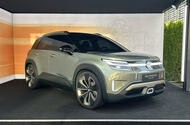What Makes the Volkswagen ID Cross Stand Out in the Electric Crossover Crowd?
If you’ve been watching the electric car market, you know it’s getting crowded—fast. But every so often, a new model pops up that makes you pause and think, “Now, that’s different.” The Volkswagen ID Cross is one of those cars. Slated to hit the roads at the end of next year, this supermini-sized electric crossover is already turning heads, and not just because of its chunky, rugged looks.
How Does the ID Cross Fit into Volkswagen’s Electric Lineup?
Let’s clear up the family tree. The ID Cross is essentially a raised, more adventurous sibling to the upcoming ID Polo hatchback. Think of it as the city-smart cousin who’s not afraid to get a little mud on their boots. It’s designed to slot just below the larger ID 4 in Volkswagen’s expanding electric range, making it an accessible entry point for buyers who want SUV practicality without the bulk or price tag of bigger models.
Volkswagen’s naming strategy is also shifting gears. Instead of sticking with the numerical “ID” system, the company is bringing familiar names to its EVs—making it easier for drivers to connect the dots between their favorite petrol models and the new electric generation. The ID Cross, for instance, is positioned as the electric counterpart to the popular T-Cross.
What’s New About the Design and Interior?
First impressions matter, and the ID Cross doesn’t disappoint. At just over 4.1 meters long and nearly 1.6 meters tall, it’s got a presence that’s both approachable and assertive. VW’s head of design, Andreas Mindt, describes it as “clear, authentic and likeable,” and you can see that in the details: a smiling 3D front light signature, chunky C-pillars reminiscent of the ID Buzz, and a stance that says it’s ready for anything.
Step inside, and you’ll notice a big shift from the glossy plastics of previous ID models. Volkswagen has wrapped almost every visible surface in pale fabric, giving the cabin a bright, lounge-like feel. The dashboard is refreshingly simple—a single horizontal band with just two digital displays: an 11-inch instrument panel for the driver and a 13-inch central touchscreen. Physical buttons are nearly extinct, replaced by a small row of touch-sensitive climate controls. Even the steering wheel gets a modern makeover, with a squared-off shape and touch panels instead of traditional stalks.
Is It Practical for Everyday Life?
Absolutely. Despite its compact footprint, the ID Cross is surprisingly roomy. The boot offers 450 liters of space—on par with larger rivals like the Volvo EX40—and there’s even a 25-liter frunk under the bonnet for smaller items. All seats can fold completely flat, making it easy to haul everything from bikes to flat-pack furniture.
The car’s dimensions also make it a sweet spot for urban drivers who need to squeeze into tight parking spots but don’t want to compromise on comfort or cargo space. And with a five-seat layout, it’s a genuine family contender.
How Does the ID Cross Perform on the Road?
Under the hood (or, more accurately, under the floor), the ID Cross uses Volkswagen’s MEB Entry electric platform. Power comes from a front-mounted electric motor delivering 208bhp to the front wheels. That’s enough for a top speed of 109mph and a range of up to 261 miles on a single charge—numbers that put it right in the mix with other small electric SUVs.
For most drivers, that means you can handle daily commutes, school runs, and even longer weekend trips without breaking a sweat. And with rapid charging infrastructure improving across Europe, range anxiety is becoming less of a worry with every passing month.
How Does It Compare on Price and Value?
Volkswagen is aiming to keep the ID Cross accessible, with an expected starting price of around £25,000. That’s about £3,000 more than the ID Polo but significantly less than the larger ID 4. For context, recent data from the Society of Motor Manufacturers and Traders (SMMT) shows the average price of a new electric car in the UK is still well above £30,000, so the ID Cross could be a game-changer for buyers looking for value without compromise.
Production will take place at VW’s Pamplona factory in Spain, alongside the Skoda Epiq—another sign that Volkswagen is betting big on small, affordable EVs for the European market.
What’s the Real-World Appeal of the ID Cross?
The ID Cross isn’t just another electric crossover. It’s a thoughtful blend of style, practicality, and affordability. Volkswagen has clearly listened to feedback from drivers who want more than just a “green” badge—they want a car that fits their lifestyle, feels good to drive, and doesn’t break the bank.
If you’re looking for a city-friendly SUV that’s just as happy on a long motorway trip, the ID Cross deserves a spot on your shortlist. It’s proof that you don’t have to sacrifice personality or practicality to go electric. And with the first models set to arrive in UK showrooms in the second half of 2026, the wait might just be worth it.
The Bottom Line: Should You Wait for the ID Cross?
If you’re in the market for a compact electric SUV that balances price, range, and everyday usability, the Volkswagen ID Cross is shaping up to be one of the most compelling options on the horizon. It’s not just about following the electric trend—it’s about setting a new standard for what a small family EV can be. Keep an eye out for the official reveal next summer. This one’s going to be worth the buzz.

